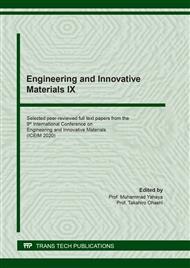p.35
p.43
p.49
p.57
p.63
p.71
p.77
p.83
p.89
A Study on the Deformation due to High Speed Processing of Aircraft Wing Structure
Abstract:
Residual stresses generated during high-speed machining of spoiler beams used in aircraft cause product deformation and dimensional mismatch, which increases the defect rate and leads to material waste. To overcome this problem, the processing site uses manual modification techniques that stretch part of the workpiece according to the experience of skilled workers. However, due to the nature of the aviation parts industry, there are no established methods for modification of product shapes and parts. Studying the modification process would allow for increased productivity, such as shorter working hours, throughout the aviation industry. In this study, a method of predicting residual stress due to frictional heat generated during high-speed machining and applying a tensile force to a model deformed by residual stress was used to modify the product. Our analysis showed that a degree of deformation similar to the measured value was produced, and that the product was modified by applying a tensile load.
Info:
Periodical:
Pages:
63-68
Citation:
Online since:
March 2021
Authors:
Price:
Сopyright:
© 2021 Trans Tech Publications Ltd. All Rights Reserved
Share:
Citation:


